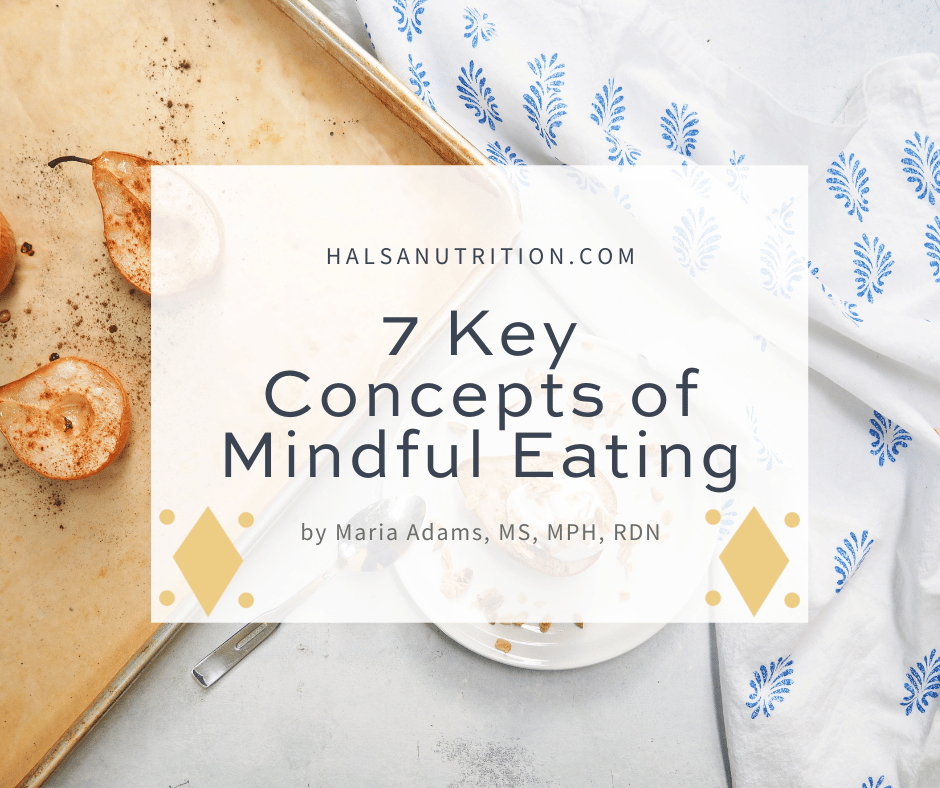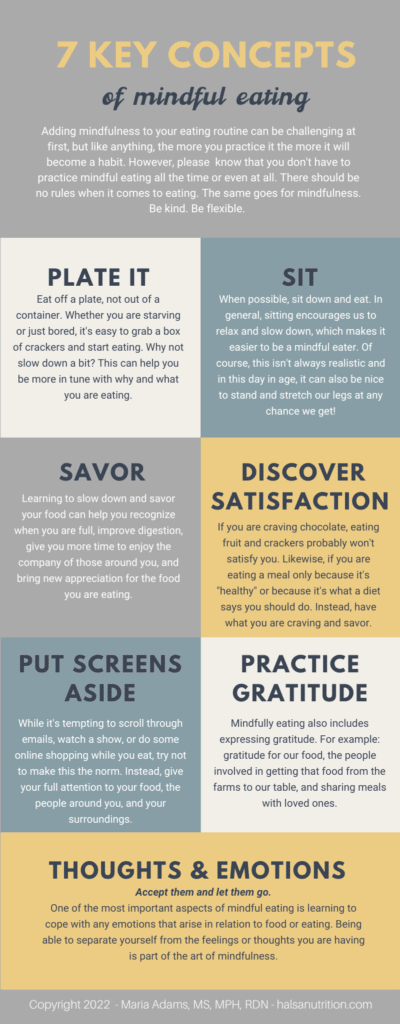
7 Key Concepts of Mindful Eating
How often are you eating mindfully? And what does this even mean? Read on to learn about 7 key concepts of mindful eating.
Estimated reading time: 7 minutes
What is Mindfulness?
Mindfulness is a Buddhist concept that essentially means being fully aware of the present moment without judgment. Eating mindfully is one component of intuitive eating. It entails being aware of everything from what you are eating to how fast you are eating to why you are eating.
Adding mindfulness to our eating routine can help us eat well and derive greater pleasure from eating. It can also help us be better in tune with our hunger and fullness. That said, it’s important to remember that these are not rules or musts — just suggestions!
It makes sense that in our fast-paced society we have gotten away from mindful eating. Read on to learn how you can bring it back…and why it’s important.
7 Key Concepts of Mindful Eating
1. Plate it.
When possible, eat off a plate, not out of a container. Whether you are starving or just bored, it’s easy to grab a box of crackers and start eating. Why not slow down a bit? Recognize how you are feeling and then prepare yourself a plate of food. This will help lead to healthier habits in many ways, for example:
- Helping you recognize why you are reaching for the crackers.
- Is it because you are hungry, tired, bored, upset, procrastinating, etc. Acknowledge the feeling or emotion without judgment and then decide if a snack is still the best solution. However, also know that it’s totally normal and ok to sometimes eat for reasons other than hunger, the key is being able to recognize it.
- Making you more mindful of how much you are eating
- Portioning food onto a plate instead of eating it out of its container can help you see how much you are eating. Of course, remember to use your hunger as a guide–not the portion size on the label.
- Helping you be more aware of what you are eating
- Is your snack balanced? For example, if you are starting with something starchy like crackers, could you add some protein (e.g.., cheese, hummus, peanut butter, turkey)? What about also adding some color (e.g., carrot sticks, apple slices, baby spinach, clementine)? Of course, remember that it’s totally ok and normal to not always have “balanced snacks.”
2. Sit.
When possible, sit down and eat. In general, sitting encourages us to relax and slow down, which makes it easier to be a mindful eater. Of course, this isn’t always realistic and in this day in age, it can also be nice to stand and stretch our legs at any chance we get!
FUN FACT: While I love my to-go coffee, I enjoy it more when I sit down and savor. One of my favorite habits is the Swedish custom of “fika” which entails taking a break in one’s day to sit down and drink a cup of coffee or tea and enjoy a snack. You can fika alone, but it’s even better in the company of friends or family.

3. Savor.
While you don’t have to “chew every bite 20 times”, there’s something the be said for this expression. Learning to slow down and savor your food can help you recognize when you are satisfied (versus all a sudden feeling uncomfortably full), decrease the amount of air you swallow (which can reduce bloating and GI discomfort), improve digestion, give you more time to enjoy the company of those around you, and bring more appreciation for the food you are eating.
To help slow down your eating try putting down your utensils between each bite. Slowly savoring your food allows you to really experience all the senses that come with it too. How does it look? smell? feel? taste?
4. Discover satisfaction.
Is your snack or meal satisfying? If you are craving chocolate, eating fruit and crackers probably won’t satisfy you. Likewise, if you are eating a meal only because it’s “healthy” or because it’s what a diet says you should do, rethink this decision. You are better off having what and how much you are craving! You can decide if you want to balance your desired food with other foods or just savor the craved item on its own. There is no “wrong.”
I love to end my lunches with a few pieces of chocolate. This makes me truly satisfied. If my kids have a little ice cream for dessert, I often have some too. These actions satisfy me. I know from experience if I try to ignore my craving I will end up thinking about it too much and then eventually having it anyway.
5. Put screens aside.
While it’s tempting to scroll through emails or do some online shopping while you eat, try not to make this the norm. Instead, give your full attention to your food, the people around you, and your surroundings.
But also note what gives you pleasure and that it’s ok to sometimes include distractions. For example, I love writing in my planner while eating breakfast as part of my morning routine. My husband loves to read the paper while enjoying brunch on the weekends. My boys love it when I make appetizers for them to enjoy while watching a big football game on TV. And we all love a good popcorn and movie night.
6. Practice gratitude.
Mindfully eating also includes expressing gratitude. Gratitude that we have food to eat. Gratitude for all the people involved in getting that food from the farm to our table. In addition, sharing meals with loved ones offers another opportunity to be grateful for their company. Let them know you are grateful to be sharing a meal with them!
7. Thoughts and emotions. Accept and let them go.
One of the most important aspects of mindful eating is learning to cope with any emotions that come up in relation to food or eating. Perhaps we feel guilty after eating “too much” or after eating something we perceive as unhealthy. Or maybe just the sight or thought of certain foods bring on thoughts of anxiety, judgment, or overanalysis. Work on recognizing these responses and then letting them go. This is a process and may take time to learn, but being able to separate yourself from the feelings or thoughts you are having is part of the art of mindfulness.
Ready to give mindful eating a try?
Great! Choose even just one of these suggestions and give it a try. Notice how it feels. Know that adding mindfulness to your eating routine can be challenging at first, but like anything, the more you practice it the more it will become a habit. However, please keep in mind:
You don’t have to practice mindful eating!
As a non-diet, intuitive eating dietitian, I’m all about no rules when it comes to eating. The same goes for mindfulness. Be kind. Be flexible. Realize that it’s unrealistic and unnecessary to ALWAYS practice mindfulness when we eat.
Want to introduce mindful eating to your kids?
Like intuitive eating, mindfulness can come second nature to young kids. However, it often quickly gets brushed aside as we start eating snacks on the go, in front of the screen, or as we rush to finish dinner to get to wherever we need (or want) to be.
Bring more mindfulness to your family by:
- Making sure you all enjoy most snacks or meals while seated and without the distraction of a screen.
- Focusing on manners at dinner. Teach the importance of showing respect and gratitude to the people who prepared the food. When possible, slow the pace down a bit, make mealtimes as pleasant as possible, and encourage kids to stay seated until everyone is done or for at least 10-20 minutes (depending on the age).
- Skipping the snacks for short trips. There is no doubt that stocking up on snacks for a long car ride or trip is a necessity when you have kids. But try to skip the snacks for most shorter car rides or stroller walks.
- Do a fun mindful eating exercise as an activity. For example, have everyone try eating a food with their eyes closed. How does it taste? How does it feel? Do you chew it quickly or try to make it last?
Looking to make mindfulness even more second nature?
Try practicing daily meditation. This can be as simple as sitting quietly with your breath for two minutes. Need a little more guidance? These days there are many great apps to get you started. Headspace, Insight Timer, and Calm are a few of my favorites. Yoga classes are also great for those who want to combine meditation with movement.

Leave a Reply